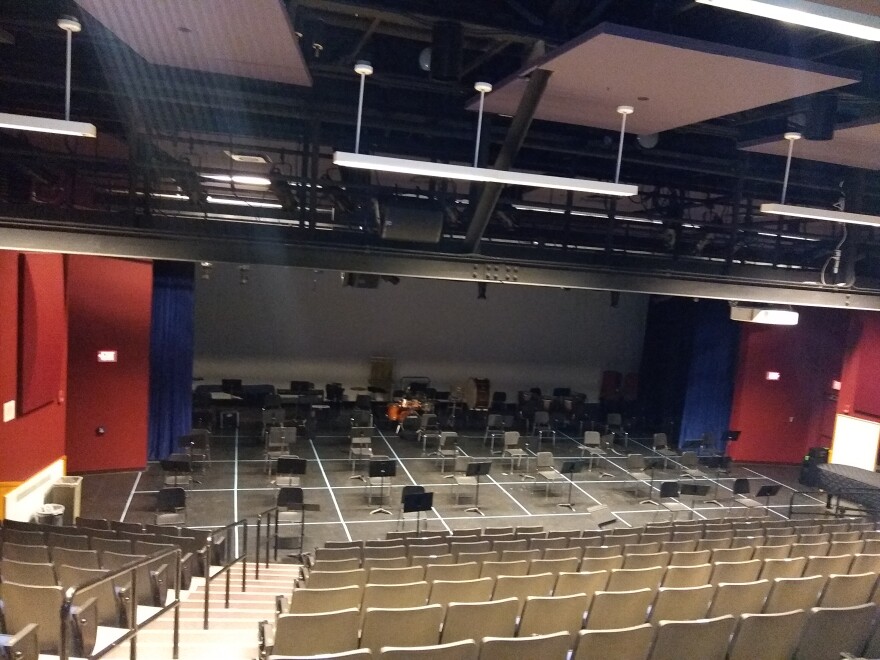Classrooms in New Hampshire have changed dramatically to reopen safely in the pandemic, and some of the biggest changes are in music class. Gone are the days of belting out songs shoulder to shoulder, sharing music stands, and swapping instruments. Instead, as NHPR’s Sarah Gibson reports, some schools are following new protocols to bring music back but keep COVID-19 risk low.
Get top New Hampshire news stories in your inbox - sign up for our newsletter today.
In band teacher Ian Nelson’s classroom, there is no such thing as a “new normal.”
“We’re taking each thing that you would take for granted and trying to find a solution to that problem,” he says. “Every day is pretty much a whole new adventure.”
Nelson’s classes at West Running Brook Middle School in Derry reopened in a hybrid model, with cohorts coming to the school a few days a week. His classroom, once full of students goofing off and playing instruments into each other’s faces, hums with air purifiers and has about a third of the students it did before the pandemic.
Without these kinds of precautions, music classes would be risky. Singing or playing an instrument requires lots of breath, sending out spit and small respiratory droplets (aerosols) that could contain COVID-19 and float in the air for hours.
This summer, a group of researchers from the University of Colorado Boulder and University of Maryland - chaired by the College Band Directors National Association and the National Federation of State High School Associations - began studying how COVID-19 could spread among performing artists.
Their preliminary results have shaped guidelines now used by music teachers across the country, including New Hampshire. The recommendations focus on masking, social distancing, and improving air flow indoors and outdoors.
Read the guidelines from the New Hamphire Music Education Coalition.

Dr. Shelly Miller, a mechanical engineer who studies air pollution and helped lead the study, says resuming music class requires a multifaceted approach.
“Keep your eye on the risk reduction,” she says. “How can you reduce your exposure? If you follow all the guidelines that we have provided, based on our science to date, the risk is going to be low. But it’s not going to be zero.”
The best way to control aerosols in instruments is to use a bell cover - basically a mask with a liner that resembles a miniature shower cap and covers the opening of an instrument. (Researchers found that a bell cover reduced the amount of aerosols coming out of a clarinet to the level of a person quietly speaking.)
Ian Nelson bought dozens of purple bell covers for his students. They use them even when rehearsing outside, spaced 10 feet apart.
“It’s just a wall of purple bell covers looking at me from different angles,” Nelson laughs. “They’re right behind their stands because some of them are pretty short.”
Teaching new notes takes longer, because Nelson has to stand far away from students when he demonstrates the fingerings on his own instrument.
There are days outside when it’s cold and fingers go numb, but Nelson says students are thrilled to be back together.
If reporting like this matters to you, support it - become an NHPR member today.

8th grade clarinetist Kylie Gaffney, a self-described “band geek,” says the coronavirus rules haven’t dampened her love for band.
“There’s just something about it that gives me joy,” she smiles.
Kylie has even found a bright side to outdoor class.
“The great thing about outside is that we can pick up little rocks and put them on the page so they don’t fly away!” she says.
Soon, Kylie’s class will move fully indoors. And that introduces a whole new set of challenges.
Hanover High School is a month into navigating COVID-19 risk among musicians indoors.
The study conducted this summer advises classes to rehearse for no more than 30 minutes at a time and to allow the HVAC systems to clean and replace the air at least once between each rehearsal.
Like many schools, Hanover reopened with an extended block schedule; now, classes are 90 minutes. This means music students have to change rooms a few times per period to meet safety standards.
Choir director Jennifer Chambers says the schedule can be overwhelming.
“My brain is super, super busy but also joyful, because being on Zoom all the time was fairly depressing for all of us chorus people who thrive on being in person and that human connection,” she says.

Chambers recently got a big shipment of “resonance” masks, a special type of mask designed for singers, with an internal frame that keeps the fabric and filter away from the mouth and makes it easier to produce a good sound.
They’re expensive - the district paid $33 a mask - and they’re huge, with thick straps for a snug fit.
“I don’t know for teenagers if it’s as aesthetically pleasing as they would like, right?” laughs Chambers. “I don’t think they’re going to be like: ‘Yeah, let’s wear our singing masks together!’”
There are also some goofy-looking masks in band - with slits at the mouth so students can blow into their instrument but cover their nose. A month in, bands report this works for almost everyone except the flute.

Alice Rodi, a senior at Hanover High, says the way she holds her flute and produces sound is impossible with a mask. So she’s going maskless. But she says for now, with low COVID-19 rates in her region, plus all the other measures - distancing, bell covers, moving between rooms - the benefits of playing in-person outweigh the risk.
“Trying to get your sounds to match the people next to you and trying to make it all sound very coherent and musical is such a big part of it,” she says.
And then there’s the social part.
“Interacting with other people and laughing when you play a very incorrect note, and just the little things that come with being in a high school band - you can’t experience those things on your own,” Rodi says.
This laughter is one of the sounds music teachers are listening for in class. They say after so many months apart, and stress about a potential surge in the months ahead, getting joy back in the building is a huge relief.
“Our biggest goal is to make the students feel safe and have fun,” says Chambers. “The music will be a bonus.”
Read more of NHPR’s COVID & The Classroom stories here. Email us tips and questions about what you’re seeing, or photos of remote learning, to education@nhpr.org









